Returns happen all the time, with 23% because the customer got the wrong item, 22% because the product looks different than the online image, and 20% because a product incurs damage during shipping.
Further, 80% of today’s audience demands hassle-free returns and 79% free shipping.
The dropshipping model, in which you outsource item procurement, warehouse storage, and shipping, can create tricky situations when customers want a refund or return.
However, it’s not like you can ignore these refund requests or risk losing your customers and, thus, your business sustainability.
So, how do you expertly navigate returns under the dropship model?
It requires communication between you and your dropshipper(s), above all else, and clear policies that you can both follow. If you’re committed to customer excellence, you’ll soon find that returns under the dropshipping model are no big deal!
In this blog post, we’ll look at how to tackle dropshipping returns and refunds and some of the best examples of dropshipping returns policies.
Let’s get started.
Table of Contents
Key Takeaways
- Creating a return policy, keeping the lines of communication open with your dropshipper, and keeping returns cost-effective for your business are critical.
- Continuously updating and optimizing your return policies based on business growth and customer feedback will enable you to keep your business profitable and your audience happy.
How to Set Up a Clear Return Policy
An accessible, transparent return policy between you, your dropshipper, and your customers is necessary. The policy should convey the following information.
Timeframes for returns
Must customers initiate a full return process within two weeks of receiving their order, or do they have up to 30 days?
Customers need to know this information if they don’t like their order, or it doesn’t fit, or it’s broken, or something else happened, and they can send it back in time.
Product condition
On that note, your return policy should include an overview of which items are eligible for returns.
Do you allow customers to return any items hassle-free, or do they need a reason to return the item, such as damage or the item not matching the product description? Make that clear in your policy.
Who covers return fees
The thing about returns is that somebody must pay for the item to be sent back to the dropshipper’s warehouse.
Will that be your business, the dropshipper, or the customer? Whatever the answer, include this information so customers are aware.
Whether the customer gets a refund or store credit
While the standard is to refund the customer, some businesses may opt for store credit.
It’s easier to issue that to a customer’s account than it is to refund them, especially when you have a third-party dropshipper involved. Whichever is the policy for your business must be stated.
Refund timeframe
Relatedly, how long will it take for customers to see their money back in their bank accounts?
Will you refund them within three or seven business days? Longer? Having this information upfront makes customers feel more confident about returning a product.
Read also: What Are Net Sales? – Formulas, Calculations, And Examples
5 Examples of Return Policies from Successful Dropshipping Stores
Let’s take a look at how various names in dropshipping handle their returns with succinct policies.
1. Shopify
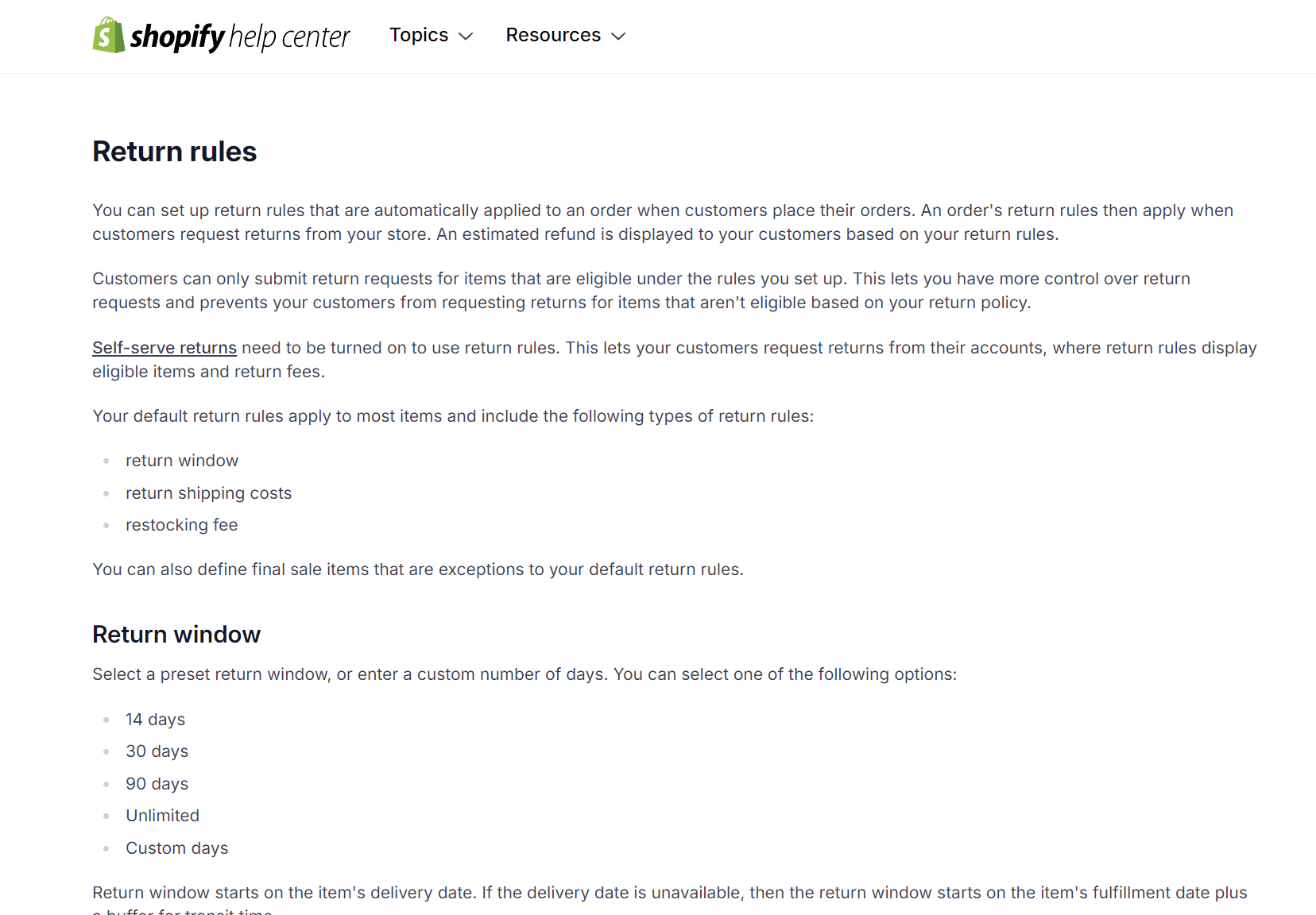
As one of the largest dropshipping and eCommerce platforms on the marketplace, the Shopify store makes its returns very clear. You can read its entire return policy here, since I couldn’t include the whole thing in one screenshot.
The policy explains Shopify’s return rules, the timeframe for allowable returns, shipping costs, restocking fees, and how to handle return requests for final sale items.
2. AliExpress
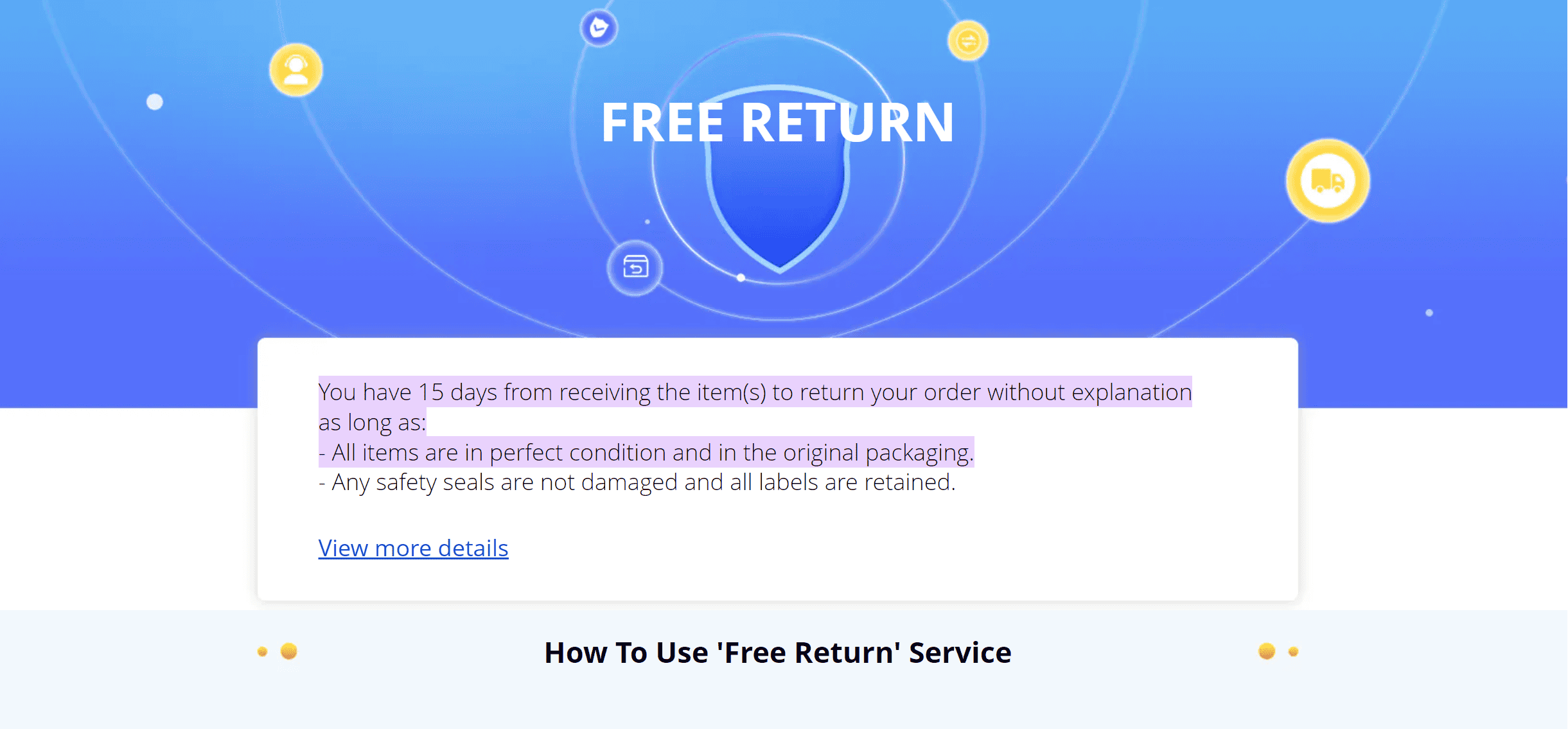
Another major name in dropshipping is AliExpress, which is popular because it offers free returns.
Customers can send in their items within 15 days of receiving them without paying a return fee or for any other reason. However, the item must not have any labels or safety seals removed, and it must be in its original package in good condition.
3. Notebook Therapy
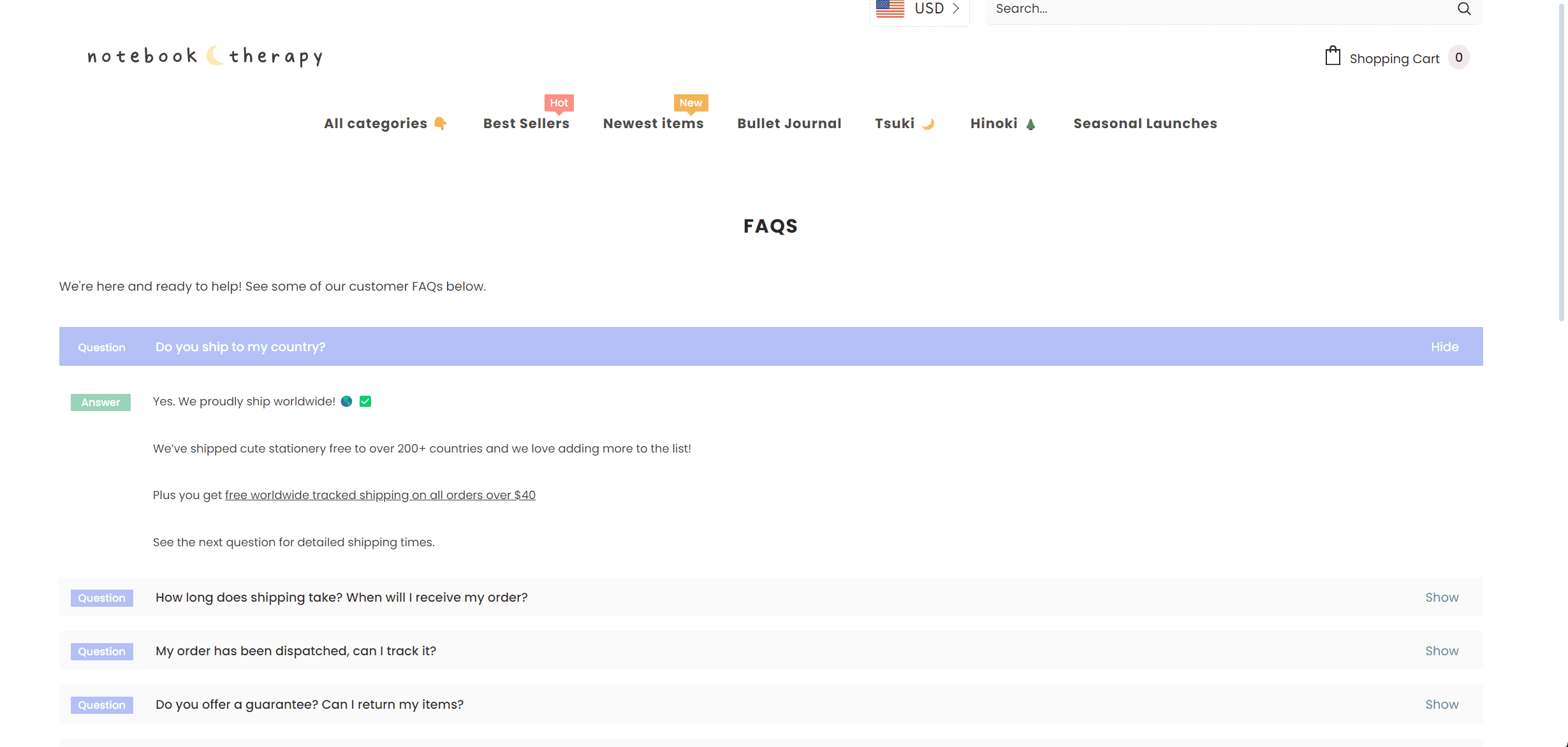
Notebook Therapy, a popular online stationery shop that uses a dropshipping business model, has a cute return page that matches its aesthetics. The page is presented in FAQ format to make finding the information easy.
Read also: How to Build an Automated Dropshipping Business
4. Sage & Sill
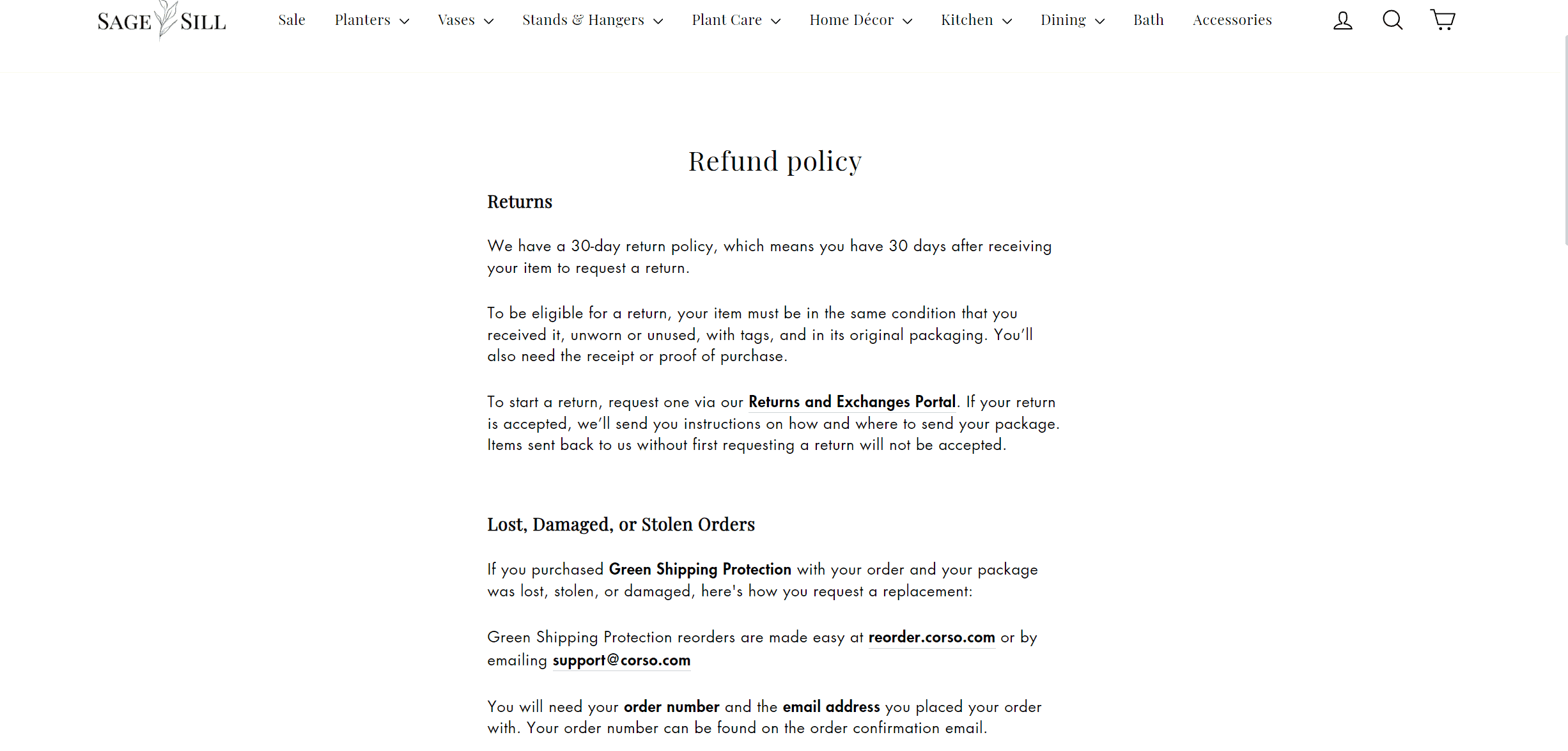
The plant store Sage & Sill, known for successfully utilizing the dropshipping model, states that customers have 30 days to issue a return and that items must be unused, in the original packaging, and with tags still attached.
Sage & Sill has its own Returns and Exchanges Portal, which accepts return requests. Only then do customers get instructions on how to send back their orders.
5. Vikings Valhalla
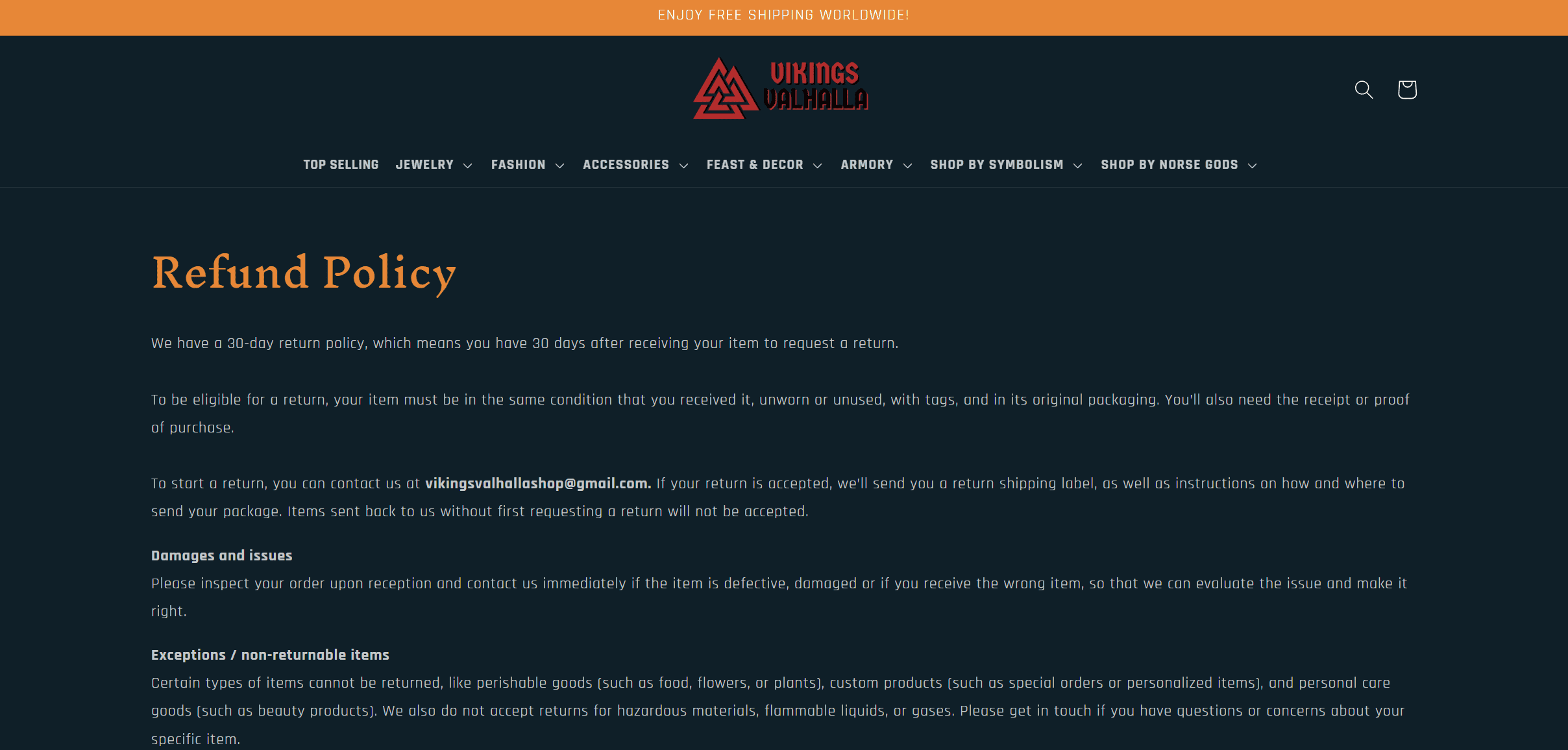
Living like a Viking is easy with Vikings Valhalla, which uses dropshipping to fulfill customer orders. Its refund policy is clearly spelled out on its website, allowing customers 30 days to return an order if it’s in excellent condition.
You’ll notice the verbiage of the Vikings Valhalla return policy closely mirrors the Sage & Sill policy. However, Vikings Valhalla doesn’t have a return portal but requires customers to send an email to request a return.
Read also: 10 Customer Service Email Templates for New CRM Users
How to Communicate with Suppliers About Returns
Returning to my point from the intro, communication between you and your supplier is key in handling returns with urgency and priority.
The conversation should ideally happen before you sign any contracts with a supplier, not afterward. That said, you can eke out a workable return policy between you and the supplier after the fact, even though it’s not necessarily as easy.
Here are the logistics you have to decide on.
Who handles returns
Will your business, as the one branding the products the customers receive, be the one to handle returns?
Or will your drop shipper do it for you? This point requires the most communication, as once you decide, it won’t be easy to switch without causing your customers a headache.
How items can be returned
Should the items be in their original packaging/boxes and have tags?
You and the supplier can decide. How can customers ship items? Can you accept returns if they use their own packaging, or will you send out a box for them to issue the return?
Who pays return fees
In some business models, the customer might pay the return fee.
In the case of AliExpress, we saw that the dropshipper would sometimes cover the fees, or you, as the business owner, may.
Who pays restocking fees
There are also restocking fees associated with returns.
These aren’t the same as return fees, as those go toward the cost of shipping the item back. Restocking fees deal with the costs of receiving, inspecting, and preparing the item to be put back for sale.
If the customer pays the restocking fee, it’s usually taken out of their refund. However, if you or the dropshipper decide to pay it, you’ll need to decide between you two who will do it and if it will be consistent across orders.
Read also: eCommerce Metrics Made Easy — How to Measure Success and Drive Growth
How to Streamline the Returns Process
The following tools and tactics should be a regular part of the returns process between you and your dropshipping partner.
Real-time inventory management software
Even though the dropshipper takes care of inventorying and warehousing, as the company supplies the merchandise, you need to know what kind of inventory is available so you can update your website accordingly.
The dropshipper benefits from real-time inventory management software, especially if they have multiple warehouses and work with other businesses. The software can help them stay abreast of your inventory so they can notify you of any shortages.
Examples of inventory management tools are NetSuite, Zoho, InventoryCloud, Cin7 Omni, and Fishbowl.
As a business owner, you should use these tools to notify the drop shipper if the stock begins running low.
RMA tools
Return merchandise authorization, or RMA, is a major part of the returns process, as the software allows the returns process to go through.
You and the dropshipper can track which items have been returned (which is worth paying attention to if customers frequently return the same item) and what you have in stock through an RMA tool.
Further, RMA software ensures that returns are handled swiftly and efficiently to maintain customer satisfaction.
Some examples of RMA tools you can try are AfterShip, ReturnGO, ServiceCentral, RMA Portal, and Odoo.
Barcode scanning software
When orders go out and especially when they come in (such as for returns), scanning barcodes will become part of the routine for your dropshipper. Having barcode scanning software handy helps you both manage inventory and review ongoing sales.
Zebra Technologies, Scandit, CodeREADr, and Sortly are some of the biggest names in barcode scanning.
Warehouse management systems
A warehouse management system or WMS makes the dropshipper’s life easier when overseeing their warehouse, with options for efficient storage, inventory tracking, order shipping, picking, receiving, and packing.
From ShipHero to Korber Warehouse Management Systems, NetSuite, Luminate Logistics, 3PL Warehouse Manager, Microsoft Dynamics 365 Supply Chain, ShippingEasy, and Oracle Fusion Cloud Warehouse Management, you have many strong options.
Automated data capture tools
Who has time to manually go through customer data? Certainly not you, and not your dropshipper, either. You’re too busy getting orders packed and shipped.
That’s what intelligent document processing, or IDP, intelligent character recognition, or ICR, and optical character recognition, or OCR, are for. Tools like OCR Studio provide solutions for fast, accurate data extraction while maintaining full data privacy.
Read also: Customer Service for Dropshipping — A Detailed Guide
Step-by-Step Guide to Handling a Return: From Request to Resolution
Customers will inevitably want to return a product; it’s part of being a business. How you handle returns will be the difference between keeping and losing your customers, so let’s review the steps to sufficiently deal with return requests.
Step 1: Determine why the customer wants to return the item
The above graphic from parcelLab reveals more reasons why customers return products than the ones I discussed in the intro.
They are, from most to least frequent, size and fit issues, product damage, the product not matching the images shown online, receiving the wrong order, and arriving too late.
You should get into a habit of tracking why customers return items, as many of these reasons come back to you, the company designing, manufacturing, and marketing the products.
If an order is sent out late, you need to straighten that out with your dropshipping partner. That’s also the case if customers get the wrong item or the order arrives damaged.
You also need accurate images of your product online. If too many customers complain because the item they received is not like the image online, this will damage your reputation and cause you to lose business.
Step 2: Receive the return request
Whether customers have to send an email or use a dedicated returns portal, all returns will occur online.
Check daily for returns, and if your returns system lets you turn on notifications, do so. This way, you won’t miss any return requests.
Step 3: Accept or deny the return request
Just because a customer asks for a return doesn’t mean you have to grant them one.
If their return request violates the terms of your return policy, such as trying to ship back an item out of its original packaging or past the return date, you can turn them down.
However, if a customer has a return request for any valid reason under the returns policy, you should approve it.
Step 4: Send a prepaid shipping label and RMA number
Next, send the customer an RMA number so you can track their return and issue them a prepaid shipping label. You can upload the label into their account or send it through email.
Step 5: Provide shipping instructions
Inform the customer of proper packing procedures so the item gets back to you in one piece.
Recommend packaging materials, tell them how to secure the box and where to stick the shipping label, and suggest where to drop off the package.
Step 6: Track the order
You can opt for return order tracking to manage the order from beginning to end. If you forego this step, you must be patient until the order arrives.
Step 7: Assess the item
Even though a customer might have shipped the item back in its original packaging and in good condition, that doesn’t mean it’s immediately suitable for resale.
You should always check the item’s quality to determine its fate, whether it’s disposed of, refurbished and sold, or restocked.
Step 8: Issue the refund
Once you have assessed the item, you can determine if the customer will get a full or partial refund. If they asked for an exchange or store credit, process them now.
Read also: Dropshipping vs Holding Inventory Model: What’s Better?
Refund Strategies to Minimize Losses
Let’s talk more about when to offer a replacement or partial/full refund, as it’s an important distinction to make, especially for small businesses trying to build up their finances.
- Replacement: If an item was broken or damaged by the shipper and not through the customer’s wrongdoing and they’d like an exchange, you should offer them a replacement. Of course, the return request should be within the return window outlined in your policy.
- Partial refund: After receiving and assessing a returned item, offer a partial refund if you determine the item was severely damaged or needs extra care to be resold. You can take the money out of the customer’s refund.
- Full refund: Customers should be issued a full refund if they return an item in perfect condition and within the return window.
So, what can your business do to minimize the financial impact? Here are some creative ideas.
Charge restocking fees
Restocking isn’t free, so why should your business incur the cost?
The average restocking fee is anywhere from 10 to 25% of the overall order value. If you decide to charge customers for restocking, ensure it’s mentioned clearly in your return policy.
Add handling charges
Handling charges are outside shipping and product costs and cover shipping materials, packaging, and storage. The charge is issued on top of subtotal fees.
Offer store credit
Issuing store credit rather than partial or full refunds ensures the customer will purchase from your store in the future, as they’ll want to use their credit before it expires.
Your credit should be equivalent to the refund value the customer would have received in cash.
Push exchanges
Exchanges are more cost-effective than paying back a customer for a returned item.
The customer can receive the same item they paid for originally but in perfect condition. Charging the customer the return shipping costs and other fees for the item exchange will further drive profits, although not by a large margin.
Read also: Top 8 Rewarding Marketing Strategies for Dropshipping for 2024
How to Deal with Customer Satisfaction and Feedback
Even with a straightforward return policy, complaints about the returns process will inevitably arise. Some might say your return window is too short or you charge too much for returns, discouraging customers from doing it.
Although you may want to, you can’t delete negative comments. It’s also imprudent to ignore them in the hopes the comments will go away, as they won’t.
Rather, taking a proactive approach to customer service is best. Address the issue immediately to try to de-escalate it, offering to chat privately and remediate it.
Once the situation is in less dire straits, it’s time to sit down and review the merits of the negative comments. Do people tend to make the same points when talking about your business, positively or negatively?
Those points are worth paying attention to, as they can influence how you do business in the future.
Legal and Financial Considerations
eCommerce laws run the gamut from intellectual property rights to shipping limits, taxes, business insurance, and customer privacy. Although it’s a lot, you must become well-versed in your jurisdiction’s eCommerce regulations related to refunds and returns.
If you don’t, you risk noncompliance, damaging your cash flow and profitability. Moreover, you can destroy customer trust and negatively impact your reputation, which is not worth it.
Take the time to learn the laws, then ensure you’re in compliance.
As your eCommerce business grows, so too must your knowledge of eCommerce laws. Once you begin shipping internationally, you’re beholden to other country’s data protection and privacy laws, among other facets.
You must also learn the tax duties that impact international dropshipping, as they will affect your finances.
Conclusion
Building a reputable dropshipping business requires efficient returns and refunds management. You need a clear, concise returns and refunds policy, made public on your website, outlining the terms, conditions, and timeframes of acceptable returns (and an overview of which fees the customer must pay).
Returns can initially be tricky, but you will learn from each and continue improving your business.
EngageBay is an all-in-one marketing, sales, and customer support software for small businesses, startups, and solopreneurs. You get email marketing, marketing automation, landing page and email templates, segmentation and personalization, sales pipelines, live chat, and more.
Sign up for free with EngageBay or book a demo with our experts.
Frequently Asked Questions (FAQ)
1. How should I set up my dropshipping return and refund policy if my supplier is overseas?
You must factor in the fact that all shipping will take longer. Consider expanding the return window for your customers, and make sure they know that it may take longer to process refunds because of the additional time required for the returned item to ship.
2. What is the best way to handle dropshipping returns and refunds without losing money?
Gently guiding your audience toward store credit or exchanges will help your company lose less money for each return. You should also consider making customers pay for return shipping and restock fees.
3. How can I prevent fraudulent returns in my dropshipping business?
You and the dropshipper should train your teams to recognize fraudulent and counterfeit products. They should learn receipt verification strategies and how to determine whether a customer is acting suspiciously.
4. Should I charge restock fees for dropshipping returns and refunds?
If you and the dropshipper have decided it makes sense for your business model, then yes, you should. The restock fee will come from the customer’s refund at the agreed-upon rate.
5. How can I use customer feedback from returns to improve my product offerings?
Review what customers love about your products and continue building momentum. Assess complaints and determine what changes may be required to your existing product descriptions and future products.
